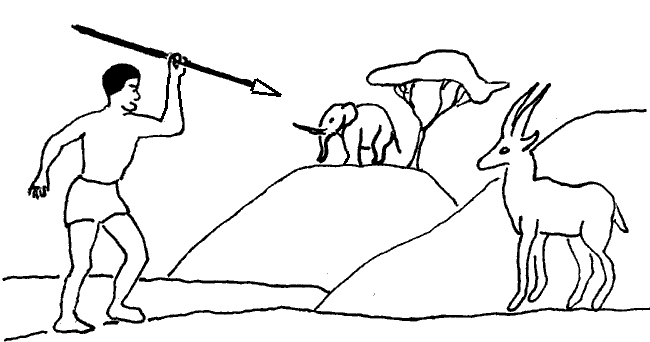
An Excerpt from Jim Conrad's
NATURALIST NEWSLETTER
April 4,
2010
issued
from Hacienda Chichen Resort adjoining Chichén Itzá Ruins in YUCATÁN, MÉXICO

The other day I heard about a 1960 study by W. Hudson conducted among South African Bantu tribal members. Study participants were shown a drawing almost identical to my own hand-drawing of his shown above.
The Bantu were asked what they saw in the picture, what the man was doing, and which was nearer, the antelope or the elephant. Both adults and children often got the answers "wrong," many saying that the man was about to spear the elephant.
Many Bantu in the study did not pick up on two cues that we in our culture instantly recognize: that nearby objects overlap objects farther away, and; that the farther away something is, the smaller it appears in a relative sense.
Though experts continue to debate what Hudson's study proves, my own reading is that the cultures we grow up in program us -- or fail to program us -- in ways that can help or hinder us in "seeing" what stands right before our eyes.
During nearly the entire history of humanity's evolution people have taken their cues on what to see and not to see from their own genetic programming and from Nature. Today a large percentage of humanity experiences only a tiny corner of Nature -- that which is human-made. As such, humanity has lost touch with many of Nature's cues on "how to see." This week I've been thinking about what our culture may be blind to, or increasingly blind to, because of Nature's missing or disappearing cues.
Because so many of us live in environments where it's not immediately clear where our food and drink come from, we've lost sight of how dangerously vulnerable we become when many middlemen stand between us and the Earth's soil.
Our intense focus on acquiring impressive or modish but unnecessary things has blinded us to the absolute necessity we all have for drinkable water, breathable air and, for our sanity, open space.
By turning a blind eye to Nature's mutually relating, harmonizing paradigms and rainbows of natural sensory stimuli, most of us no longer see the beauties of simplicity, the charm of empathy and cooperation, and the spiritual nourishment provided by thoughtful and artful expression in everyday life.
Well, one can go on like this, but the question is, what is one to do?
In the Northern Hemisphere, spring is coming. Depending on how far north you live, crocuses, irises or daffodils are blossoming. Spring Peepers are peeping in lots of places and migrating birds are soon to arrive. Before long the forests will be greening, butterflies flitting, and crickets chirping.
Here's what to do: As if you were learning to see for the first time, pay attention to the cues Nature is offering on how to see the world around us.